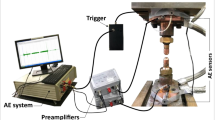Abstract
Refrigerated ammonia storage tanks (RAST) are hazardous industrial facilities, where accidents with severe consequences occur. Defects of welded joints are one of the main reasons of RAST accident occurrence. Due to this, during the technical inspection, special attention is paid to quality control of welded joints. The use of non-destructive testing (NDT) for defect detection is essentially important as it can be used to assess the integrity of such critical steel structures as storage tanks. Among the several NDT techniques available, acoustic emission (AE) can supply valuable information assessing structural integrity, detecting flaws and leaks in base metal and welded joint. However, assessing structural integrity usually includes other NDT techniques (e.g., visual examination, ultrasonic testing, dye penetrant test) additionally to AE, providing complementarity between different NDT techniques. Nevertheless, conventional NDT methods are aimed at detecting only the defects that occurred during manufacturing and operation and do not assume stress-strained state (SSS) assessment. The metal magnetic memory (MMM) technique is a passive magnetic one that is recommended to be applied for SSS assessment in accordance with guidance documents. A flaw detectability relation between UT and MMM techniques is observed.



















Similar content being viewed by others
References
V.A. Kotlyarevsky, A.A. Shatalov, H.M. Hanukhov. Safety of tanks and pipelines. – Moscow: “Economics and Informatics” Publishing house, 2000. – 555 p.; illustrated
H.M. Hanukhov. Analysis of the causes of steel tanks accidents and improvement of their operation safety / Chemical and oil and gas engineering. – Moscow, No.10, 2003. – pp. 49–52
H.M. Hanukhov. Analysis of the causes of tank accidents, design, regulatory and technical support for their safe operation / Collection of articles of the International Scientific and Practical Conference “New structural solutions, technologies for construction and repair of steel tanks”. NEFTEGAZMASH. - Samara, - N. Novgorod, 2007. – pp. 112–120
GD 03–410-01 Guidelines for carrying out a comprehensive technical inspection of liquefied gas refrigerator tanks
Method of metal magnetic memory (MMM) and inspection instruments. Training handbook. Document No: V-1347-06r4. Compiled by Dubov AA, Dubov Al. A, Kolokolnikov SM, Edited by the Editorial Committee of Commission V under the Chairmanship of Gerd DOBMANN, Fraunhofer, Germany, Commission V, International Institute of Welding, Date of Issue 09.07.06
ISO 24497–1:2020, Nondestructive testing—metal magnetic memory—part 1: vocabulary and general requirements, 2020
ISO 24497–2:2020, Nondestructive testing—Metal magnetic memory—part 2: inspection of welded joints, 2020
A.A. Dubov. Fundamental features distinguishing the metal magnetic memory method and inspection instruments compared to known magnetic non-destructive testing methods / A.A. Dubov // Control. Diagnostics. - 2003. - №No.12. - pp.27–29
Kolokolnikov SM, Dubov AA, Marchenkov AY (2014) Determination of mechanical properties of metal of welded joints by strength parameters in the stress concentration zones detected by the metal magnetic memory method. Welding in the World 58(5):699–706
EN 14620-1. Design and manufacture of site built, vertical, cylindrical, flat-bottomed steel tanks for the storage of refrigerated, liquefied gases with operating temperatures between 0 °C and 165 °C
N. N. Gubarev, G. D. Stenin. NDT of weld seams of inner shells of liquid ammonia isothermal storage tanks: carrying out and results. – NDT World, 4 (46). 2009. pp.74–76
Kolokolnikov S, Dubov A, Steklov O (2016) Assessment of welded joints stress–strain state inhomogeneity before and after post weld heat treatment based on the metal magnetic memory method. Welding in the World 60(4):665–672
Dubov A, Kolokolnikov S (2010) Comprehensive diagnostics of parent metal and welded joints of steam pipeline bends. Welding in the World 54(9–10):R241–R248
A.A. Dubov, Al.A. Dubov, S.M. Kolokolnikov: Determination of mechanical properties by hardness parameters in stress concentration zones detected on industrial equipment during inspection by the metal magnetic memory method. IIW Document No: XI-981-12
STO 00220256–005-2005 Butt, fillet and T-welded joints of pressure vessels and apparatuses. Technique for ultrasonic testing
GOST R 55724–2013 Non-destructive testing. Welded joints. Ultrasonic methods
ISO 6520-1:2007 Welding and allied process-classification of geometric imperfections in metallic materials—part 1: fusion welding
Author information
Authors and Affiliations
Corresponding author
Additional information
Publisher’s note
Springer Nature remains neutral with regard to jurisdictional claims in published maps and institutional affiliations.
Recommended for publication by Commission V - NDT and Quality Assurance of Welded Products
Rights and permissions
About this article
Cite this article
Kolokolnikov, S., Dubov, A., Medvedev, A. et al. Comprehensive inspection of refrigerated ammonia storage tank welded joints by the metal magnetic memory technique and conventional NDT methods. Weld World 64, 1659–1670 (2020). https://doi.org/10.1007/s40194-020-00938-8
Received:
Accepted:
Published:
Issue Date:
DOI: https://doi.org/10.1007/s40194-020-00938-8




